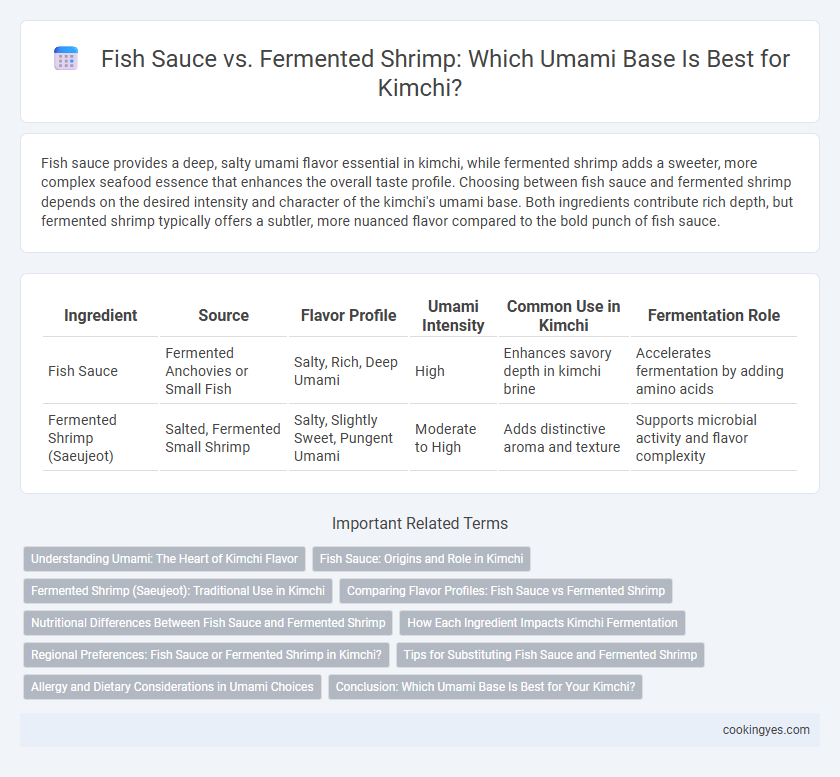Fish sauce provides a deep, salty umami flavor essential in kimchi, while fermented shrimp adds a sweeter, more complex seafood essence that enhances the overall taste profile. Choosing between fish sauce and fermented shrimp depends on the desired intensity and character of the kimchi's umami base. Both ingredients contribute rich depth, but fermented shrimp typically offers a subtler, more nuanced flavor compared to the bold punch of fish sauce.
Table of Comparison
| Ingredient | Source | Flavor Profile | Umami Intensity | Common Use in Kimchi | Fermentation Role |
|---|---|---|---|---|---|
| Fish Sauce | Fermented Anchovies or Small Fish | Salty, Rich, Deep Umami | High | Enhances savory depth in kimchi brine | Accelerates fermentation by adding amino acids |
| Fermented Shrimp (Saeujeot) | Salted, Fermented Small Shrimp | Salty, Slightly Sweet, Pungent Umami | Moderate to High | Adds distinctive aroma and texture | Supports microbial activity and flavor complexity |
Understanding Umami: The Heart of Kimchi Flavor
Fish sauce and fermented shrimp both serve as essential umami bases in kimchi, providing deep savory notes that define its flavor profile. Fish sauce offers a balanced, salty richness derived from fermented fish proteins, while fermented shrimp adds a slightly sweeter, more pungent complexity thanks to its amino acid content. Understanding the unique umami qualities of these ingredients helps achieve the authentic depth and character characteristic of traditional kimchi.
Fish Sauce: Origins and Role in Kimchi
Fish sauce, a staple condiment originating from Southeast Asia, plays a crucial role in enhancing the umami base of kimchi by providing a deep, savory flavor that complements the fermented cabbage and spices. Made through the fermentation of fish and salt, fish sauce introduces complex amino acids that intensify the overall taste profile of kimchi. Its distinct salty and umami-rich character balances the tanginess and heat, solidifying fish sauce as an essential ingredient in traditional kimchi recipes.
Fermented Shrimp (Saeujeot): Traditional Use in Kimchi
Fermented shrimp, known as Saeujeot, plays a vital role as the umami base in traditional kimchi, offering a distinct savory depth that enhances the dish's complex flavors. Saeujeot is preferred over fish sauce in many Korean recipes due to its balanced saltiness and delicate fermentation aroma, which complements the crispness of Napa cabbage. This ingredient's unique enzymatic properties aid in fermentation, contributing to kimchi's characteristic tang and rich umami profile.
Comparing Flavor Profiles: Fish Sauce vs Fermented Shrimp
Fish sauce delivers a sharper, brinier umami with salty and savory notes that penetrate kimchi deeply, enhancing its complexity. Fermented shrimp offers a milder, slightly sweeter umami, contributing a subtle seafood aroma and soft texture that balances the robust fermentation flavors. Choosing between fish sauce and fermented shrimp depends on whether a bolder, more pungent flavor or a gentler, nuanced umami is desired in the kimchi base.
Nutritional Differences Between Fish Sauce and Fermented Shrimp
Fish sauce contains higher levels of sodium and provides a strong umami flavor primarily from anchovy fermentation, offering essential amino acids and minerals such as calcium and magnesium. Fermented shrimp has a richer profile of protein and contains more vitamins like B12 and iron due to the whole crustacean fermentation process. Both condiments contribute beneficial probiotics but differ nutritionally, with fish sauce being lower in fat and fermented shrimp offering more micronutrients.
How Each Ingredient Impacts Kimchi Fermentation
Fish sauce introduces a rich, savory depth to kimchi by accelerating fermentation through its high concentration of amino acids and natural enzymes. Fermented shrimp adds a more complex umami profile with subtle briny sweetness, influencing both the flavor complexity and microbial activity during fermentation. The choice between fish sauce and fermented shrimp shapes the kimchi's texture, aroma, and overall taste intensity by selectively promoting specific lactic acid bacteria essential for the kimchi fermentation process.
Regional Preferences: Fish Sauce or Fermented Shrimp in Kimchi?
Regional preferences in kimchi production distinctly influence the choice between fish sauce and fermented shrimp as the umami base, with southern Korean provinces like Jeolla favoring fermented shrimp for its robust and slightly sweet flavor. In contrast, regions such as Gyeongsang commonly use fish sauce, which imparts a cleaner, saltier umami that complements the kimchi's crisp texture. These variations reflect local seafood availability and deeply rooted culinary traditions that shape the distinctive taste profiles of regional kimchi varieties.
Tips for Substituting Fish Sauce and Fermented Shrimp
When substituting fish sauce in kimchi recipes, opt for tamari or soy sauce with a splash of seaweed broth to maintain umami depth without overwhelming saltiness. For fermented shrimp, blend miso paste and a small amount of dried seaweed to mimic the complex fermentation flavor and add savory richness. Adjust quantities gradually to preserve the characteristic umami profile essential to authentic kimchi taste.
Allergy and Dietary Considerations in Umami Choices
Fish sauce and fermented shrimp both serve as potent umami bases in kimchi, yet they differ significantly in allergy and dietary implications. Fish sauce, derived from anchovies, poses risks for individuals with fish allergies, while fermented shrimp may trigger shellfish allergies and sensitivities. For dietary considerations, vegan and vegetarian diets favor plant-based umami alternatives over both fish sauce and fermented shrimp to avoid animal allergens and maintain dietary restrictions.
Conclusion: Which Umami Base Is Best for Your Kimchi?
Fish sauce offers a robust and savory umami flavor that deeply enhances the complexity of kimchi, while fermented shrimp provides a milder, subtly sweet seafood essence that complements delicate vegetable textures. Choosing the best umami base depends on personal taste preferences and the desired intensity of flavor, with fish sauce favoring a bold profile and fermented shrimp creating a lighter, nuanced taste. Many traditional recipes combine both for a balanced depth, but for those seeking a strong, pungent kick, fish sauce remains the optimal choice.
Fish Sauce vs Fermented Shrimp for Umami Base Infographic

 cookingyes.com
cookingyes.com